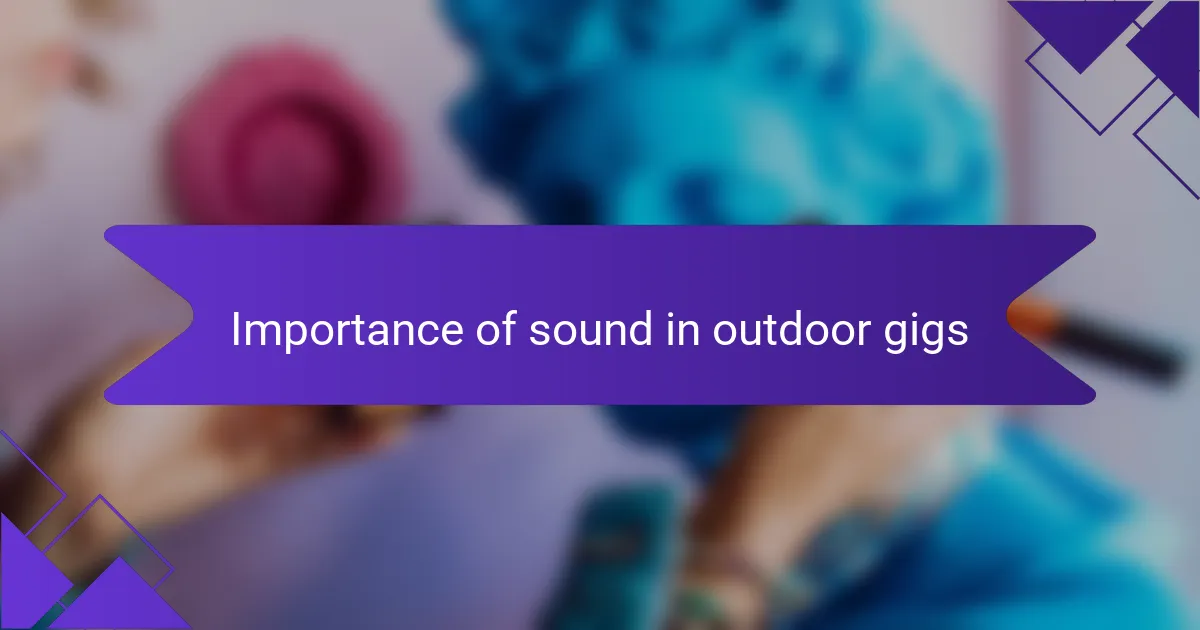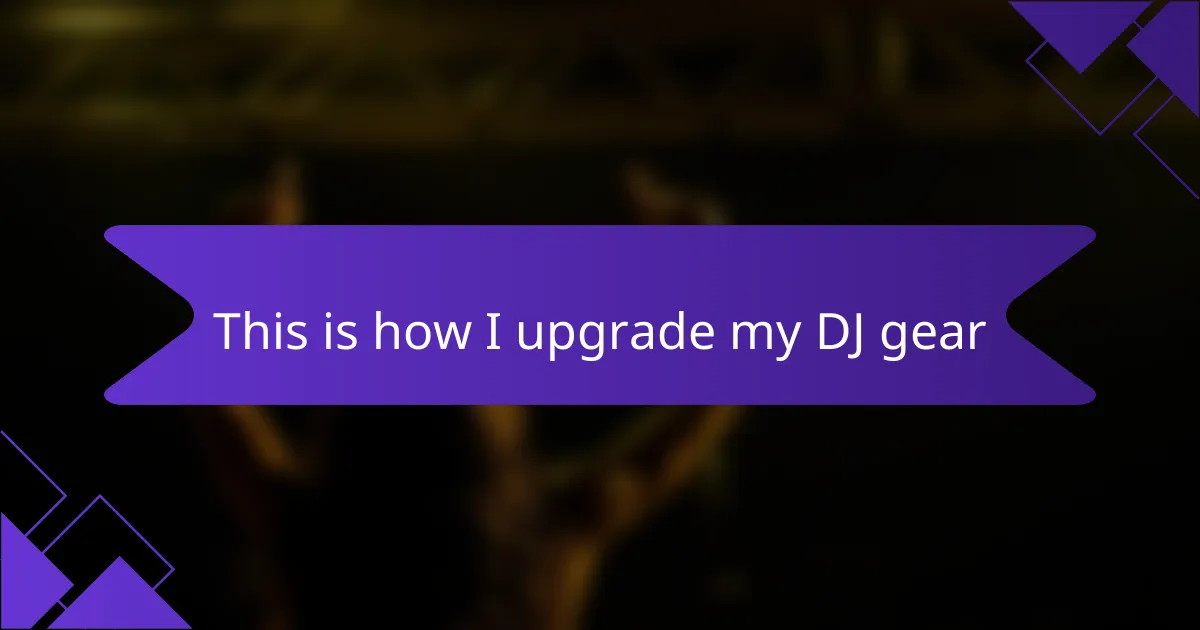Key takeaways
- DJ entertainment is about creating an engaging atmosphere by connecting with the audience and managing sound quality effectively.
- Choosing the right equipment, such as portable PA systems or line array speakers, is essential for outdoor gigs to ensure quality sound distribution.
- Speaker placement should be optimized, ideally using a triangular formation and elevating speakers to enhance clarity and reduce distortion.
- Regular maintenance and troubleshooting of sound equipment are crucial to avoid issues like audio distortion during performances.

Understanding DJ entertainment
DJ entertainment is all about creating an unforgettable experience for your audience. I’ve found that good DJs not only play great music but also engage the crowd and keep the energy flowing. I remember my first outdoor gig; the challenge of balancing sound levels with nature was intense but exhilarating, turning the whole event into something magical.
Understanding the different elements of DJ entertainment is crucial. It’s not just about the music; it’s about the vibe, the connection with the audience, and how the equipment is set up. Each outdoor setting presents unique challenges, from acoustics to power sources, but getting it right can transform a typical gathering into a memorable celebration.
Here’s a comparison of some key aspects of DJ entertainment and outdoor settings:
| Aspect | Indoor Setup | Outdoor Setup |
|---|---|---|
| Acoustics | Controlled environment | Influenced by wind and open space |
| Power Sources | Stable electrical outlets | Generators may be required |
| Audience Engagement | Close proximity | Need for larger space management |

Importance of sound in outdoor gigs
The sound quality in outdoor gigs is crucial for creating the right atmosphere and engaging the audience. I’ve experienced firsthand how poor sound can impact an event; I remember one summer festival where the speakers distorted the music, and it felt like a missed opportunity to connect with the crowd. Good sound allows for a seamless experience, enabling the audience to fully enjoy the performance and feel connected to the music.
In my opinion, investing in quality equipment and ensuring proper setup can make or break an outdoor event. When I’ve taken the time to calibrate the sound system correctly, the energy is palpable, and the audience responds in a way that’s incredibly rewarding. It’s all about making sure every note can be heard clearly, regardless of the venue’s acoustics.
Here’s a comparison table summarizing some key factors regarding sound in outdoor gigs:
| Factor | Importance |
|---|---|
| Sound Quality | Enhances audience experience and interaction |
| Volume Level | Ensures clarity without overwhelming the crowd |
| Equipment Quality | Reduces distortion and improves overall performance |
| Setup Positioning | Affects dispersal of sound and audience engagement |

Types of speakers for outdoor use
When it comes to outdoor gigs, choosing the right type of speaker is crucial for delivering a quality experience. I’ve learned from my own experiences that portable PA systems are often the go-to choice for DJs like myself. They’re lightweight, easy to set up, and provide ample power for crowds of various sizes.
However, if you’re really looking to make an impact, consider using line array speakers. I remember using them at a summer festival; the sound projected evenly across the space, leaving the audience mesmerized. Their ability to cover a large area without distortion is unmatched, making them ideal for outdoor events where you want everyone to feel the music.
- Portable PA Systems: Lightweight and compact, ideal for smaller gatherings or easy transport.
- Line Array Speakers: Excellent for large crowds, providing even sound distribution.
- Subwoofers: Enhance bass and depth in outdoor settings, perfect for dance music.
- Battery-Powered Speakers: Offer flexibility and are perfect for locations without access to power.
- Water-Resistant Speakers: Essential for outdoor events where weather might be an issue.

Key equipment for connecting speakers
Connecting speakers for outdoor gigs requires a specific set of equipment to ensure a smooth experience. In my experience, the most critical piece is the mixer. A quality mixer allows for control over levels and sound adjustments, letting me adapt to the shifting acoustics of an outdoor space. I recall a gig where the wind carried sound away, and it became clear that adjusting my levels through the mixer was essential to maintain the audience’s engagement.
Cables might seem like a minor detail, but they are vital for reliable connections. I’ve faced frustrations with poor-quality cables that resulted in unwanted noise or even total sound loss during a performance. Investing in durable, well-shielded cables has always paid off for me. I like to keep a couple of extras on hand, just in case; you never know when the unexpected will strike during a live show.
Another indispensable tool is a power source, especially for outdoor events. Depending on where you’re set up, you might need a generator or battery packs. I remember one gig where the venue’s power failed, and having a backup generator allowed me to continue without a hitch. If you prioritize having a stable and adequate power supply, your sound system will thrive, creating the kind of atmosphere that leaves a lasting impression on your audience.

Best practices for speaker placement
When it comes to speaker placement, one of the most effective strategies is to create a triangular formation. I’ve found that positioning the speakers at the front corners of the audience area optimizes sound coverage. It ensures that sound reaches everyone evenly, which is key to making sure nobody feels left out of the action. I recall a festival where I didn’t maximize this setup, and some folks near the back missed out on that euphoric sound experience. It’s moments like these that really highlight how speaker placement can either make or break the vibe.
Another best practice is to elevate the speakers. I learned the hard way during an outdoor wedding when my speakers sat on the ground. The sound got muddied by grass and other elements, which detracted from the emotion of the moment. Elevating speakers not only improves clarity but also helps prevent sound distortion caused by surfaces absorbing or reflecting sound waves. Additionally, when speakers are elevated, they’re less likely to be obstructed by the crowd, allowing for a more immersive experience.
Don’t forget about the importance of distance from walls and structures. In my early days, I placed speakers too close to a building and learned about echo and feedback the hard way. I’ve since made it a priority to keep the speakers at least several feet away from any barriers. This simple adjustment allows sound to disperse freely, enhancing the overall auditory experience. Have you ever noticed how moving a speaker just a bit can change everything? It’s fascinating how such small shifts can have such large impacts on sound quality.

Troubleshooting common sound issues
Sometimes, even the best-laid plans can hit a snag when connecting speakers for outdoor gigs. I remember a particular event where we faced severe audio distortion during soundcheck. It turned out that the cables were slightly damaged. After a quick replacement, though, we managed to salvage the performance, and it reminded me how essential it is to regularly check equipment before an event.
When troubleshooting sound issues, here’s a straightforward list to guide you through the process:
- Check all cable connections; loose or damaged cables can cause unwanted noise.
- Verify your signal source to ensure it’s functioning properly.
- Adjust EQ settings to eliminate unwanted frequencies that may cause feedback.
- Test your speakers individually to isolate any faulty units.
- Keep an eye on the power levels; overloading can lead to distortion.
Through experience, I’ve learned that staying calm and organized in these moments makes all the difference in resolving any sound issues quickly.



